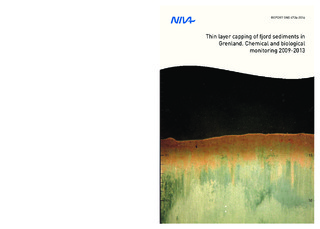Thin layer capping of fjord sediments in Grenland. Chemical and biological monitoring 2009-2013
Research report
Permanent lenke
http://hdl.handle.net/11250/284003Utgivelsesdato
2014Metadata
Vis full innførselSamlinger
- NIVA-rapporter [6997]
- Publikasjoner fra Cristin - NIVA [2151]
Originalversjon
NIVA-rapport. 52 p. Norsk institutt for vannforskning, 2014Sammendrag
A field experiment on thin layer capping was initiated in the Grenland fjords in September 2009. A primary objective
of the field experiment was to assess the capacity of the different cap designs to reduce bioavailability of dioxins as well
as the disturbance and recovery expected of the benthic habitat and macrofauna communities. The test fields were
investigated in samples collected in 2009, shortly after capping, and in 2010, one year after capping. The bioavailability
was determined in box-cores transferred from the test fields to a mesocosm laboratory for ex situ measurements of
uptake of dioxins in sediment-living organisms and passive samplers exposed in the overlying water. The results
showed that caps containing activated carbon effectively reduced the bioavailability of dioxins, but adverse effects were
found on benthic communities. In one of the two test fields treated with activated carbon, the community severely
deteriorated during the first year after capping. In order to follow the further succession of the benthic community and
the degree of sustainment of dioxin immobilization, extended monitoring was performed in 2012 and 2013, 3-4 years
after cap placement. Here we report the results from this latter investigation and compare with the results obtained in
the previous investigations. The new results confirmed maintenance of positive effects of activated carbon on the
bioavailability of dioxins. The benthic habitat appeared to have improved since 2010, but adverse effects were still
present in the macrofauna communities, in particular at one of the test fields treated with activated carbon at which
recovery appeared to have stagnated at about two years after cap placement.

